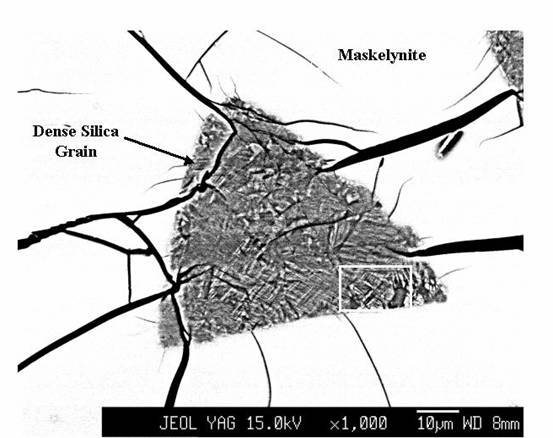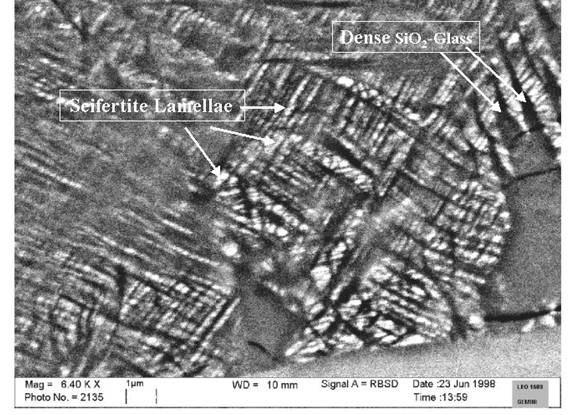3.3 h. Seifertite: A new natural very dense post-stishovite
polymorph of silica (T.G. Sharp/Tempe, A. El Goresy/Mainz, L.S. Dubrovinsky, M.
Chen/Guangzhou, B. Wopenka/St. Louis, P. Dera/Washington DC, C.T.
Prewitt/Tucson, N.Z. Boctor/Washington DC and R.J. Hemley/Washington DC)
In the last two decades, considerable interest has been devoted to the
response of silica to extreme pressure conditions using both diamond anvil
high-pressure devices and First Principles Calculations. This interest stems
from the possibility of the existence of dense free silica in Earth’s mantle.
Silica is a major component of the Earth. Based on the chondritic model,
SiO2 makes up 50 wt.% of Earth’s bulk. Possible natural polymorphs of
silica denser than stishovite are also important for understanding the behaviour
of SiO2 in the Earth's interior and during natural dynamic events on
planetary surfaces. High-pressure diamond anvil cell (DAC) experiments revealed
that silica undergoes several phase transitions to “post-stishovite” (polymorphs
denser than stishovite) phases above 48 GPa. Stishovite inverts displacively
above 48 GPa to a CaCl2 I -structured-polymorph (space group
Pnnm), a polymorph that contains silicon in distorted octahedrons. It has
been shown experimentally and by First Principles Calculations that this
polymorph is stable up to 78 GPa. Beyond that pressure the CaCl2
polymorph transforms displacively to a denser species with the
α-PbO2-like structure with kinked chains of SiO6octahedra
(space group Pbcn or Pb2n).
The Shergotty and Zagami SNC (possibly Martian in origin) meteorites contain
silica grains with lamellar structure previously misidentified as PDF in quartz.
Silica occurs as large (150-900 µm) prismatic grains, rhombic-or triangular
shaped cross sections typical of orthorhombic β-tridymite morphology. The
morphology of the cross sections is also consistent with cristobalite. Every
silica grain consists of mosaics of domains (10-60 µm in size Fig. 3.3-9) each
displaying two orthogonal sets of lamellae that havedifferent brightness in Back
Scattering Electron (BSE) mode in the Field-Emission Scanning Electron
Microscope (FESEM). The brighter lamellae consist of a dense crystalline
SiO2 phase and the dark ones of dense SiO2 glass (Fig.
3.3-10). Electron microprobe analyses with a defocused beam on the widest
lamellae showed almost pure SiO2 with minor concentrations in
Na2O (0.40 wt.%) and Al2O3 (1.14 wt.%). The
lamellae are extremely sensitive to electron bombardment and are destroyed
within a few seconds under a focused electron beam, despite the use of low
sample current (< 5 nano-Amps). An attempt to determine the nature of the
lamellae by laser microRaman spectroscopy failed due to the instantaneous
vitrification under the focused laser beam, despite the use of low laser power.
 |
|
Fig. 3.3-9: A back scattered electron (BSE) photomicrograph of a
triangular dense silica grain from the Shergotty meteorite. The grain
consists of numerous domains of a maximum diameter of 60 µm. Each domain
displays an orthogonal pattern of bright (seifertite) and dark (dense
SiO2 glass) lamellae. |
 |
|
Fig. 3.3-10: A BSE-SEM detail of the area within the white box in Fig.
3.3-9. White lamellae are seifertite and the black lamellae consist of
dense SiO2 glass, probably formed by vetrification of another
metastable post-stishovite silica plolymorph |
X-ray diffraction and TEM investigations revealed that the dense crystalline
silica in Shergotty is a new orthorhombic species (Space Group Pbcn or
Pb2n) with the following cell parameters: a 4.097(1) Ĺ, b
5.0462(9) Ĺ, c 4.4946(8) Ĺ, V 92.92 Ĺ3, Z = 4. Calculated
density = 4.309 g/cm3 (with empirical formula) and 4.294
gm/cm3 (with pure SiO2). High-pressure DAC experiments on
cristobalite revealed a phase transformation above 40 GPa to the
α-PbO2-like structure. This strongly suggests that this species
formed on the SNC parent body at peak-shock pressures slightly in excess of 40
GPa. The Commission of New Minerals and Mineral Names of IMA (International
Mineralogical Association) approved the nomination of this very dense silica
species after Friedrich Seifert (seifertite).

